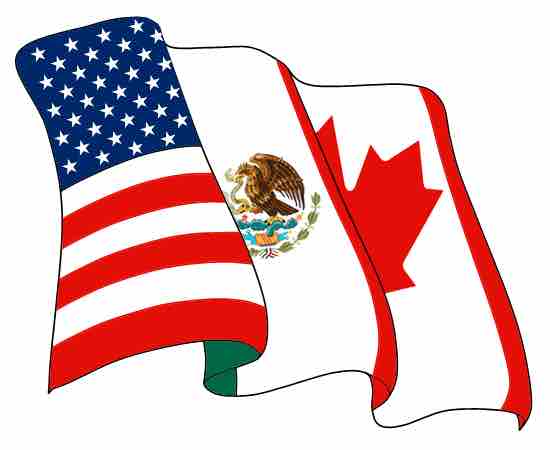NAFTA
The North American Free Trade Agreement (NAFTA) is an agreement between Mexico, the United States and Canada. The agreement was signed by US President George H.W. Bush, Canadian Prime Minister Brian Mulroney, and Mexican President Carlos Salinas on December 17, 1992 in San Antonio, Texas, and took effect on January 1, 1994.

NAFTA
NAFTA is an agreement between the US, Mexico and Canada, as represented by the 3 flags in its logo.
The bill removed taxes on products traded between the three countries. It also protects copyright, patents, and trademarks between those countries. It was updated with the North American Agreement on Environmental Cooperation, which helped reduce pollution and set more environmental regulations. It was also updated with the North American Agreement for Labor Cooperation, which helped people fight for better labor conditions.
Effects
Since NAFTA took away taxes for products traded between the US, Canada, and Mexico, Mexico has been buying more products from the US. It saved U.S. companies the cost of selling products to Mexico, and saved Mexican companies the cost of buying items from US companies.
A benefit of the bill is that labels on products exchanged between the three countries come in French, English and Spanish. That way, Mexicans and Americans who speak Spanish can read the Spanish label, Americans and Canadians can read the English label, and Canadians who speak French can read the French label.
NAFTA also encourages more immigration from Mexico to the US. Since small businesses can no longer be protected by tariffs, many small business owners in Mexico cannot compete with the prices of subsidized products from the US. As a result, many Mexicans have gone to the US looking for work. Some believe that NAFTA has been positive for Mexico, which has seen its poverty rates fall and real income rise.
Others argue that NAFTA has been beneficial to business owners in all three countries, but has had negative impacts on farmers in Mexico. Mexican farmers have seen food prices fall due to cheap imports from US agribusiness, while US workers in manufacturing and assembly industries have lost jobs. Critics also argue that NAFTA has contributed to the rising levels of inequality in both the US and Mexico.
Goals of NAFTA
NAFTA was created to eliminate barriers to trade and investment between the US, Canada and Mexico. The implementation of NAFTA immediately eliminated tariffs on more than one-half of Mexico's exports to the US and more than one-third of US. exports to Mexico. Within 10 years of implementation, all US-Mexico tariffs would be eliminated except for some US agricultural exports that were to be phased out within 15 years. NAFTA also seeks to eliminate non-tariff trade barriers and to protect the intellectual property right of the products.
In the area of intellectual property, the North American Free Trade Agreement Implementation Act made changes to the copyright law of the US, foreshadowing the Uruguay Round Agreements Act of 1994 by restoring copyright (within NAFTA) on certain motion pictures which had entered the public domain.
Trade
The agreement opened the door for free trade, ending tariffs on various goods and services, and implementing equality between Canada, the US and Mexico. Since the implementation of NAFTA, the countries involved have been able to do the following:
- The US had a services trade surplus of $28.3 billion with NAFTA countries in 2009 (the latest data available).
- Foreign direct investment of Canada and Mexico in the US (stock) was $237.2 billion in 2009, up 16.5% from 2008.
- Income in the maquiladora sector has increased 15.5% since the implementation of NAFTA in 1994.
- To alleviate concerns that NAFTA would have negative environmental impacts, in 1994 the Commission for Environmental Cooperation (CEC) was given a mandate to conduct ongoing ex-post environmental assessment of NAFTA.
- Agriculture is the only section that requires three separate agreements between each pair of parties. The Canada–US agreement contains significant restrictions and tariff quotas on agricultural products, whereas the Mexico–US pact allows for a wider liberalization within a framework of phase-out periods.
- Mexico has gone from a minor player in the pre-1994 US export market to the 2nd largest importer of U.S. agricultural products.
- According to the Department of Homeland Security Yearbook of Immigration Statistics (2006), 73,880 foreign professionals were admitted into the US for temporary employment under NAFTA.